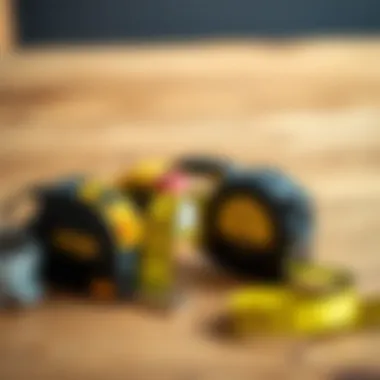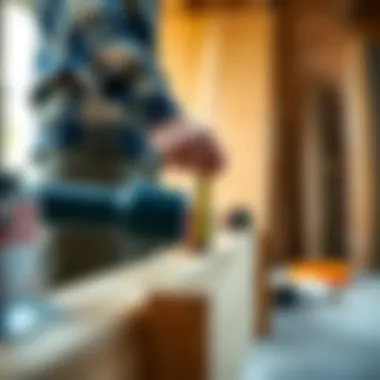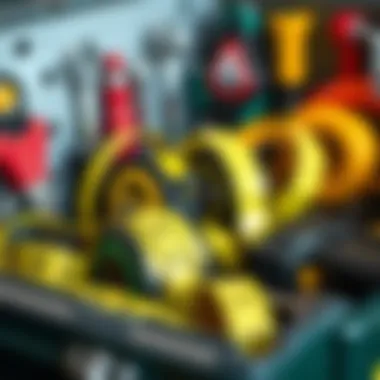The Complete Guide to Understanding Tape Measures


Intro
Tape measures are among our everyday heroes, often underestimated yet profoundly important in various fields. From architects sketching blueprints to savvy homeowners measuring for the perfect new piece of furniture, the tape measure is an essential tool majorly unrecognized. The precision it offers can be the difference between a perfectly fitting shelf and a disaster where everything seems just a little off.
This guide aims to shed light on the evolution, diversity, and utility of tape measures. We will delve into the different styles available in today’s market, drawing connections to emerging trends in furniture design and how each correlates to modern DIY projects. Understanding the landscape of tape measures not only enhances your measuring skills but also empowers you in making more informed decisions as you shape your living spaces.
In addition to practical aspects, this piece will offer a deeper appreciation for these tools that we often overlook in our rush to create aesthetically pleasing areas in our homes. In the end, we hope this exploration equips both professionals and DIY enthusiasts with the insights they need to measure twice and cut once, adhering to the age-old adage that remains relevant in the craft today.
Prologue to Tape Measures
Tape measures, often regarded as one of the most essential tools in both professional and DIY environments, play a pivotal role in ensuring accuracy and precision in measurements. This guide seeks to unravel the intricacies of tape measures, covering their historical background, types, and practical applications. Understanding this tool not only enhances one’s ability to undertake projects—be it in construction, design, or crafting—but also expands one’s knowledge of measuring techniques that have been a cornerstone of various industries.
Definition and Purpose
A tape measure is a flexible measuring device made of a long strip marked with units of measurement. Usually enclosed in a protective casing, it can be extended and retracted easily, making it a convenient option for everyone from carpenters to homeowners looking to tackle a project. The primary purpose of a tape measure is to acquire precise measurements of distances, lengths, and sizes, thus facilitating an array of tasks such as installing furniture, laying out walls, or even measuring fabric for a sewing project.
However, the functionality extends beyond just measuring; it offers a way to ensure that projects turn out exactly as envisioned. Nobody wants to discover that the new bookshelf won't fit in the intended space because of poor measuring.
Importance in Various Industries
Tape measures find their application across numerous sectors, reflecting their versatility and the necessity of accurate measuring tools. In construction, these devices are indispensable; workers rely on them during every phase of building, from foundations to finishing touches. A wrongly measured component can spell disaster on a job site, leading to costly errors and delays.
In interior design, tape measures allow designers to sketch layouts that maximize space and functionality. Accurate dimensions ensure that furniture aligns perfectly with the scale of a room. Similarly, in arts and crafts, tape measures assist hobbyists in achieving symmetry and proportions in their creations.
Here are some key areas where tape measures are crucial:
- Construction: Ensuring structural integrity through precise measurements.
- Interior Design: Crafting layouts that balance aesthetics with space constraints.
- Retail Operations: Managing space for optimal product placements and displays.
- Event Planning: Accurately setting up stage and seating arrangements for events.
In summary, tape measures aren't just tools; they're gateways to successful projects across numerous fields. Given their importance, having a solid grasp of their features and functions ensures that users can take full advantage of this simple, yet remarkably effective device.
Historical Context
Understanding the historical context of tape measures enriches our appreciation for this essential tool. It is fascinating to see how measuring devices have evolved over centuries. The story of tape measures is not just about the transformation of a measuring tool but reflects the advances in technology, craftsmanship, and the needs of society.
Early Measuring Tools
Before tape measures became commonplace, societies relied on rudimentary tools for measurements. Ancient civilizations utilized basic methods like knots on a string or the length of a foot. In ancient Egypt, for example, the royal cubit was used as a standard measure, often based on the dimensions of pharaohs themselves. These early tools, while innovative in their time, often lacked precision, leading to discrepancies in measurements across various trades and crafts.
Craftsmen needed reliable methods to measure materials accurately, especially as construction projects grew more complex. This drive for precision led to the development of rolly measuring devices as early as the 15th century, often made from materials like leather or cloth and used in tailoring and construction. They were practical yet wholly varied in quality and size, from tapes resembling the width of a man’s thumb to those extending up to 100 feet.
Evolution to Modern Tape Measures
With the onset of the industrial revolution in the 18th century, the demand for precision skyrocketed. This era saw significant innovations including the introduction of metal tape measures. Steel became the material of choice because of its durability and accuracy. Tools were also made more standardized, with consistent scales marked clearly on the tapes. No longer limited by the size of a craftsperson, these steel tapes allowed for longer measurements and grew in popularity among builders and designers alike.
In the 20th century, the tape measure underwent another change with the addition of mechanisms like the lock system, allowing users to hold the tape in place, ensuring a new level of accuracy. Also, ribbon tapes allowed easier coiling and storage. Later on, digital tape measures emerged, integrating technology into the traditional tape measuring concept, making them easier to read and sometimes offering additional functionalities like distance, area, and volume calculations.
"Innovation isn’t just about technology; it’s about solving problems effectively. Tape measures are a perfect example of this evolution."
All these developments paved the way for the modern tape measure we know today. It serves not only as a tool for accurate measuring but also as a representation of human ingenuity across different ages and industries. The historical context shows that with every change in society's needs and capabilities, measuring tools adapted and evolved into something more efficient and accessible, making accurate measurements a norm rather than an exception.
From the ancient knot to a high-tech digital device, the journey of the tape measure illustrates a fascinating blend of practicality and human creativity. Understanding this trajectory helps in appreciating the value and versatility of tape measures in today’s world.
Types of Tape Measures
Tape measures might seem like simple tools for measuring distance, but diving into the different types reveals a variety of features tailored for specific tasks. Knowing the types of tape measures available allows users to choose the right tool for their needs, enhancing accuracy and efficiency in various applications. Here, we'll explore the three primary types of tape measures: steel, flex, and digital, discussing their unique aspects and uses.
Steel Tape Measures
Steel tape measures are the traditional choice, often found in both professional and home settings. Made from durable steel, these tape measures provide accuracy over long distances without sagging. They usually have a significant feature: a sturdy blade that retracts into a housing, making them portable and easy to store. The markings on these tapes are typically printed in inches and centimeters, catering to a wide audience.
Benefits of Steel Tape Measures:
- Durability: The steel blade resists wear and tear, lasting much longer than plastic options.
- Precision: These measurements tend to be more reliable due to less elasticity compared to other materials.
- Versatility: Suitable for various applications, from construction to home decorating.
However, one must handle them with care to avoid injury from the sharp edges. The retracting blade can also snap back if not handled properly, which can be a concern for less experienced users.
Flex Tape Measures
Flexible tape measures, often made from fiberglass or cloth, provide a different approach. They are lightweight and easily bendable, allowing users to measure curves or irregular shapes. This makes them particularly popular among seamstresses and DIY crafters, where precise measurements of fabric can be challenging with rigid methods.
Key Features and Benefits of Flex Tape Measures:


- Lightweight Design: Ideal for carrying around in pockets or bags without adding excess weight.
- Flexibility: Their bendable nature allows for accurate measurement of rounded objects or surfaces.
- Readability: Many have large printed numbers and markings, making them easy to read from a distance.
On the downside, flex tape measures may not offer the same accuracy over long distances, as they can sag in the middle. They are also prone to wear and tear, particularly if frequently exposed to the elements.
Digital Tape Measures
In the age of technology, digital tape measures have emerged as a game-changer. Equipped with digital displays, these tape measures automatically calculate measurements, with some even storing data for future use. They often include features like built-in Bluetooth technology, which allows users to sync measurements with other devices, making them invaluable for professionals who require precision and speed.
Advantages of Digital Tape Measures:
- Convenience: Instant readings eliminate the risk of misinterpretation common with traditional tapes.
- Enhanced Features: Many come with additional functions like Pythagorean calculations, adding significant value.
- Memory Storage: The ability to save measurements is particularly helpful for ongoing projects or quotes.
Nonetheless, these tools can come at a higher price point and require battery power, which might not suit all users. Care must be taken to protect them from drops or water damage, as they can be more fragile than their tape counterparts.
Pros and Cons of Each Type
When choosing a tape measure, consider the specific pros and cons of each type to find one that fits your needs:
| Type | Pros | Cons | | Steel Tape Measures| - Durable
- Precise
- Versatile | - Can be heavy
- Risk of injury from snapping blade | | Flex Tape Measures | - Lightweight
- Flexible
- Easy to read | - Less accurate over long distances
- Prone to wear and tear | | Digital Tape Measures| - Instant readings
- Enhanced functionality
- Memory storage| - Higher cost
- Requires batteries
- Sensitive to impacts |
Components of a Tape Measure
Understanding the components of a tape measure is crucial to appreciating its functionality and utility across various tasks, from home renovations to professional construction projects. Each part plays a specific role and contributes to ensuring accurate measurements and ease of use.
Blade and Housing
The blade is the most visible part of a tape measure and is often made from steel or fiberglass, coated for durability. Its surface usually has markings printed with measurements, both in imperial (inches) and metric (centimeters). This dual-scale is essential as it caters to a broader audience of users who might be switching between measurement systems.
The housing—where the blade is stored—serves more than just to keep it protected. Good housing is made of hard plastic or metal, designed to withstand drops and wear. This is especially important for professionals who often work on job sites filled with potential hazards. A well-constructed housing also allows the tape measure to be both lightweight and easy to carry. The combination of a robust blade and durable housing ultimately impacts the tape measure's lifespan and performance.
Lock Mechanism
A sturdy lock mechanism is an often-overlooked yet vital component of a tape measure. It allows users to hold the blade in place during measuring, preventing it from retracting accidentally and ensuring precision. The locking mechanism can vary significantly in design and function. Some tapes feature a push button while others may have a sliding lock.
A reliable lock not only prevents slips and miscalculations but also adds a layer of safety, especially when measuring at heights. If the tape is not locked in place, it can retract suddenly, potentially causing injury or damaging materials. For professionals and DIYers alike, understanding which lock mechanism suits their needs can make a considerable difference in efficiency and safety.
End Hook and Its Functionality
At first glance, the end hook of a tape measure might seem like a simple metal piece glued to the end of the blade. However, it plays an essential role in achieving accurate measurements. The end hook is usually designed to slide a bit, allowing for measurements taken from either side of the tape—taking into account its thickness.
When measuring outward, the hook should be flush against the object being measured. Conversely, if measuring inward, the hook's zero mark compensates for its thickness. This clever design element saves time and reduces errors. Given the importance of accuracy in projects ranging from construction to crafting, a well-functioning end hook can make a world of difference.
"Precision is not just a goal; it’s necessary for successful outcomes in any project."
In summary, the components of a tape measure aren’t just trivial parts; they play significant roles that enhance usability, precision, and safety. Understanding these components allows users to select the most suitable tape measures for their specific needs, further elevating their measuring capabilities.
How to Use a Tape Measure
Using a tape measure might seem straightforward, but there are nuances that make a significant difference in achieving precision. The ability to measure correctly is fundamental in various settings, from construction sites to interior decoration and even in crafting. Understanding how to effectively use this tool can streamline your projects and save you time and costs associated with errors.
By knowing the proper techniques, you enhance your capacity to create spaces that are not only functional but also aesthetically pleasing. This section will detail the basic measuring techniques and provide valuable tips to ensure accurate measurements whenever you reach for your tape measure.
Basic Measuring Techniques
To get started, familiarize yourself with the components of your tape measure. Most tape measures have a flexible blade that retracts into a compact housing, marked with increments for distance. Here are the essential steps to measure effectively:
- Choose the Right Position: Ensure the surface you’re measuring against is stable. If measuring a wall, position yourself directly in front of it. For horizontal measurements, ensure your tape is level to avoid skewing the data.
- Extend the Tape: Smoothly pull the blade out from the housing until you reach the desired length. It’s wise to avoid jerking the tape as this can lead to mismeasurement.
- Secure the End: For accurate readings, hook the end of the tape onto the starting point, whether it’s the edge of a wall or a piece of lumber. This end hook is essential, as it accounts for its thickness.
- Read the Markings: Pay close attention to the primary measurements, usually in inches or centimeters. Most tape measures also have smaller markings to indicate 1/8 and 1/16 of an inch. Knowing how to read these fine increments is important for delicate work.
- Document Your Measurements: Always jot down your measurements immediately either on paper or using a note app. This helps avoid confusion later, especially if you’re measuring multiple items.
By mastering these fundamental techniques, you’ll be in good stead to tackle a variety of measuring tasks.
Tips for Accurate Measurements
Even seasoned users can make mistakes when measuring, so here are some strategies to ensure your measurements are spot-on:
- Double-Check: Don’t rely on your first measurement. It’s a good habit to measure twice to confirm accuracy. A second reading can catch an error before you proceed.
- Use a Level: When measuring particularly long distances or when setting straight lines, using a level in conjunction with your tape measure can ensure that everything is plumb.
- Keep the Tape Clean: Dust or debris on the tape can affect the readings. Wipe your tape measure with a dry cloth occasionally to keep it clean and functioning properly.
- Avoid Slippage: Hold the tape securely while measuring. If the tape bends or slips, it can lead to incorrect measurements.
- Consider the Material: Different materials can expand or contract depending on environmental conditions, particularly in construction. Take note of these factors if you’re working outdoors.
"Accuracy in measuring isn’t found in how you hold the tape, but in the method you use it. Precision matters."
By implementing these strategies, you can ensure that your measurements are not just close; they are precise. Whether you're measuring for a new piece of furniture, a renovation, or a simple DIY project, these techniques can save you time, effort, and resources.


Applications of Tape Measures
Tape measures are invaluable tools, their significance stretching across various sectors. This section hones in on the diverse applications of tape measures, emphasizing why understanding their use is essential for homeowners, designers, and DIY enthusiasts alike. With the right knowledge of how to employ these measuring tools, one can tackle any project—big or small—with confidence.
In Construction
In the construction realm, tape measures are non-negotiable. They serve as the skeleton upon which structures are built. From laying foundations to installing drywall, precise measurements are the backbone of successful construction projects. An inch off can lead to disaster, costing both time and money.
- Measuring Dimensions: For any construction project, accuracy starts with measuring length, width, and height. Tape measures help construction workers determine exact dimensions for walls, doors, and windows.
- Aligning Structures: Ensuring everything is square and level is essential. Tape measures allow workers to check if materials align properly, especially when framing.
- Layout Planning: Before any construction begins, using a tape measure helps in spacing out where fixtures, outlets, or even beams should be positioned.
The construction industry relies on the everyday tape measure, as it plays a crucial role in the calibration of tools, ensuring every aspect of the build adheres to original plans.
Interior Design and Furniture Layout
In the world of interior design, correctly measuring space opens up a myriad of possibilities. Tape measures allow designers and homeowners to utilize every nook and cranny effectively—not just to display furniture, but to create a harmonious living environment.
- Space Analysis: A tape measure makes it easy to know whether a sofa will fit beneath a window or if a dining table will allow for comfortable movement around it.
- Room Planning: Designers can play Tetris with furniture placements without the hassle of moving heavy items repeatedly. Accurate measurements ensure that every piece has its rightful place.
- Scale Models: For conceptual visualization, designers often draft scale models. A tape measure becomes indispensable when measuring for scale in designs, making ideas more tangible.
Through tape measures, the art of crafting a balanced interior emerges—where function meets aesthetics seamlessly.
Arts and Crafts Projects
For arts and crafts enthusiasts, tape measures are not just for a project’s practicality—they ignite creativity. From DIY home décor to intricate crafts, these tools can transform the mundane into the extraordinary.
- Precision Cutting: When creating custom pieces, accurate measurements guarantee symmetry and balance, essential for achieving professional results in homemade art.
- Recycling Materials: Tape measures can guide crafters who repurpose old furniture into new creations, ensuring that every dimension is met for a seamless integration.
- Design Templates: Many projects require careful layouts. Whether it’s painting a mural or sewing a quilt, reaching for the tape measure helps crafters draw out precise outlines or patterns.
Ultimately, tape measures are tools of empowerment for creative minds, enabling them to bring their visions to life.
"A project is only as good as its planning, and that starts with a thorough measurement."
Choosing the Right Tape Measure
Choosing the right tape measure can make a world of difference when it comes to accuracy and ease of use in any project. As foundational as measuring tools are, finding the correct one tailored to your needs can improve both efficiency and outcome. The right tape measure increases the likelihood of precise measurements, which is paramount in any field—be it construction, design, or even simple home DIY tasks. Thus, understanding the aspects that make a tape measure suitable for specific tasks is key for homeowners, renters, designers, retailers, and DIYers alike.
Factors to Consider
When selecting a tape measure, there are several factors to weigh. Not all tape measures are created equal, and different features cater to diverse needs. Here are a few essential considerations:
- Length: Tape measures come in various lengths, commonly ranging from 12 to 33 feet, designed to suit different projects. A 25-foot tape is typical for many jobs, but consider your specific needs.
- Blade Width: The width of the blade can influence how easily it can bend or stay straight over longer distances. Wider blades offer better stability, making them ideal for measuring longer spans.
- Material: Tape measure blades are generally made from either steel or fiberglass. Steel tapes are robust and durable, while fiberglass versions are flexible and resistant to tearing but may be less suitable for heavy-duty tasks.
- Graduation Markings: Look for clear and easy-to-read markings. Some measures offer fractional markings which can be handy for precise tasks.
- Lock Mechanism: A dependable locking mechanism helps maintain the blade's position. A secure lock is especially important when measuring alone.
By considering these factors thoroughly, you’ll be more equipped to choose a tape measure that harmonizes with your measuring tasks.
Quality vs. Cost
The age-old adage of you get what you pay for rings true when it comes to tape measures. While opting for a budget tape measure might seem appealing in the short term, it may not serve well in the long run. Investing in a quality tape measure might require a bit more upfront cash, but it pays off in reliability and longevity.
When evaluating quality, consider the following aspects:
- Durability: Higher-priced tape measures often utilize superior materials and design, which can endure the wear and tear of regular use.
- Inclusion of Features: At times, a more costly tape may come equipped with non-slip grips, magnetic hooks, or reinforced housing—features that make usage easier and increase accuracy.
- Manufacturer Reputation: Brands with a solid foothold in the market tend to produce tools that stand the test of time. Researching reliable brands, such as Stanley or Milwaukee, can provide insights into which models are worth the extra money.
While it might be tempting to save a few dollars, purchasing a reliable tape measure is an investment into the success of your projects.
"A poor tool can hinder your project more than you might think, costing time and materials along the way."
Maintenance of Tape Measures
Keeping your tape measure in top-notch condition is crucial for accurate measurements and longevity. Just like any tool, if it's not properly maintained, it will degrade over time and can lead to inaccurate readings. In this section, we’ll delve into the nitty-gritty of cleaning and care, as well as smart storage solutions. By the end of this, you should see that a little bit of effort goes a long way in extending the life of your tape measure, ensuring it's a dependable ally in your measuring tasks.
Cleaning and Care
A clean tape measure is a reliable tape measure. Dust, dirt, and debris can accumulate in the casing and on the blade, affecting its performance. To keep your tape measure in prime condition, follow these simple cleaning steps:
- Wipe the Blade: Use a soft cloth (a microfiber cloth works wonders) to wipe the blade. Avoid abrasive materials as they can scratch the surface and lead to inaccuracies.
- Check for Rust: If you have a steel tape measure, inspect it for any signs of rust. If you find any, a light application of a rust remover can help. Just be cautious; overuse can damage the blade.
- Inspect the Housing: Give the housing a once-over. Look for any cracks or damage that may affect its ability to withstand daily use. If you see something off, don’t ignore it. Repair or replace the tape measure if necessary.
- Lubricate the Lock Mechanism: Dry locks can jam and make it difficult to pull out the tape. A small dab of lubricant can ensure the lock and mechanism generally work smoothly.
- Remove Debris from the Casing: Sometimes the casing can catch lint and debris. Regularly cleaning the edges keeps it free from getting gummed up.
Regular maintenance is like preventive medicine for your tape measure. A few minutes here and there can save you from measuring mishaps down the line.
Storage Solutions
Where you keep your tape measure is just as important as how you care for it. Storing a tape measure carelessly can lead to bends in the blade, which can greatly affect its accuracy over time. Here are several storage solutions:
- Dedicated Tool Storage: Use a tool belt or a box designated for measuring tools. This keeps it out of harm's way.
- Wall Hanger: For those who love a tidy workspace, consider a wall-mounted tape measure holder. It keeps it at an accessible height without risking damage.
- Avoid Weight on the Blade: If you toss your tape measure in a toolbox, make sure nothing heavy is resting on it. Excessive weight can cause it to warp.
- Use a Sheath: Some tape measures come with a protective sheath or casing. If yours does, use it. If not, consider getting one.
- Avoid Humid Spaces: Storing your tape measure in damp areas can invite rust and corrosion, particularly for metal tape measures. Keep it in a dry place, away from fluctuating temperatures.


"A little care and attention can transform a good tool into a great one."
Taking the time to maintain and properly store your tape measure is an investment in its longevity. After all, a reliable tape measure will keep you on the right track in all your projects, ensuring precision at every turn.
Innovative Uses for Tape Measures
Innovative uses for tape measures go well beyond the basic task of measurement. This section explores creative applications that showcase the versatility of this essential tool, emphasizing its importance for homeowners, DIY enthusiasts, and professionals alike. Beyond their primary function, these innovative techniques tap into the potential for increased efficiency, accuracy, and even aesthetic enhancement in various projects.
Creative DIY Projects
When it comes to DIY, a tape measure becomes an invaluable ally. Here are a few imaginative ways to utilize this tool:
- Wall Art Creation: Use the tape measure to define geometric shapes on your walls with painter's tape, creating eye-catching designs that add depth to any room.
- Framing Level: Hang picture frames perfectly straight by measuring from the floor to the top of the frame, ensuring a professional look in your gallery wall.
- Custom Shelving: Whether it's floating shelves in the kitchen or a bookcase in the living room, using a tape measure allows for precise spacing and layout adjustments, allowing you to maximize both space and function.
Not only do such projects make the most of your tape measure, but they also elevate your living environment, injecting personality and style.
Unconventional Measuring Techniques
Tape measures can also inspire unconventional measuring techniques that extend beyond standard linear measurements. Here are some noteworthy methods:
- Curved Surfaces: To measure a curved surface—such as the back of a chair or a rounded wall—simply lay the tape along the curve and take note of the reading. This technique provides you with accurate data for projects where traditional straight measurements fall short.
- Distance Estimation: When the tape won’t suffice due to its limited length, use it as a guide to estimate longer distances. By measuring a known interval and counting how many times it fits into the larger space, you can achieve a close approximation without needing an extensive tape measure.
- Creating Templates: For custom projects like crafting or cabinetry, you can cut a piece of cardboard to the length you need and use that as a template—just trace around it. This method often improves accuracy, especially for repeated designs.
Using these unconventional techniques not only saves time but also helps maintain precision in tasks that may seem daunting without the right tools in hand.
The tape measure is not just a tool; it's a gateway to creativity, efficiency, and craftsmanship in your projects.
By embracing these innovative uses, you can maximize the utility of your tape measure and apply fresh ideas into your daily tasks or significant renovations.
Safety Considerations
Safety should always be at the forefront when working with tape measures, as their incorrect use can lead to injuries. Understanding safety considerations can prevent accidents and ensure a smoother measuring experience. With the right knowledge, users can be confident in their handling, thereby making their projects safer and more effective.
Avoiding Injuries
One of the primary concerns when using a tape measure is the potential for physical harm. There are various ways to avoid injuries, especially when handling the device.
- Rewind Caution: When you retract the tape measure, it can snap back quickly. Always keep your fingers away from the blade while retracting it. A sudden snap could pinch or even injure digits quite easily.
- Sharp Edges: The metal blade can have sharp edges, especially if it has been worn or damaged. Inspect it before use. If you see any fraying, it is advisable to replace the tape to avoid injury.
- Proper Readings: Often, users find themselves squinting or leaning too far towards the tape for a reading. This can lead to a loss of balance and potential falls. Ensure that you position yourself in a safe and secure stance while checking the measure.
- Secure Environment: Make sure the area around you is free from clutter and hazards. This includes keeping any tools secured and not letting your workspace become overcrowded. An unkempt area can increase the chances of slipping, tripping, or other injuries during measurement tasks.
Future of Tape Measures
In the ever-evolving landscape of tools and technology, the future of tape measures is not just about maintaining tradition but also embracing innovation. For homeowners, DIY enthusiasts, and professionals alike, understanding how tape measures will advance is crucial. This section explores the significance of these developments and what they entail for various users.
Technological Advancements
The rise of smart technology has permeated every aspect of everyday tools, and tape measures are no exception. The introduction of digital tape measures has revolutionized the way we measure lengths. Modern tape measures now come equipped with features such as Bluetooth connectivity, enabling seamless transfer of measurements directly to smartphones or tablets. Imagine measuring a room and having the data automatically sent to your design software without lifting a finger.
- Laser Measurement: Many new models integrate laser technology, allowing users to gauge distances accurately over larger spans. This is particularly beneficial in construction and design industries, where precision is paramount.
- Virtual Assistants: Some advanced tape measures boast voice command capabilities, making it easier for users to take measurements even when their hands are full.
- Integrated Calculators: Certain tape measures have built-in calculators that can perform quick area and volume calculations, which further streamlines project workflow.
The rapid pace of these advancements signifies a shift towards more efficient and user-friendly measuring processes. As technology progresses, it’s safe to speculate that even more remarkable innovations will emerge, refining how we think about measuring tools.
Trends in Usage
With the ongoing evolution of tape measures, their application in various fields is also experiencing noteworthy trends. As we move further into the digital age, we see a blending of traditional methods with modern practices.
- Home Automation and Construction: The construction sector is increasingly integrating smart home technology. Tape measures are part of this, with builders using them as inputs for smart devices that manage energy efficiency or home layouts.
- DIY Movements: There's a growing trend in DIY projects, thanks in part to the accessibility of information found online. Tape measures remain a staple for enthusiasts looking to enhance their skills and craft stunning home improvements.
- Customized Designs: More individuals are gravitating towards bespoke furniture and interiors. Tape measures play a critical role in creating custom solutions that fit personal styles perfectly, from measuring wall space for art to calculating dimensions for one-of-a-kind furniture pieces.
"As technology integrates deeper into our everyday tools, precision and functionality are enhanced, driving new uses and making life easier."
For those curious about modern tape measures and further advancements in tool technology, consider exploring resources from Wikipedia or specialized forums on Reddit. Their insights could offer a deeper understanding of how these changes will continue to shape our practices.
Ending
In wrapping up this exploration of tape measures, it’s essential to emphasize why understanding this tool is vital for anyone who engages in measuring tasks, whether for professional projects or personal ones. The accuracy and practicality offered by tape measures are fundamental, especially in fields where precise dimensions can make or break a project. A faulty measurement can lead to significant time and financial losses, ultimately underscoring the importance of mastering the correct use of tape measures.
Summarizing Key Points
Throughout this guide, we have touched on several key aspects:
- Types of Tape Measures: We defined the differences between steel, flexible, and digital tape measures, outlining when each type excels. For instance, while steel tape is invaluable for construction due to its durability, a digital tape measure can provide instant readings and is perfect for those who prioritize technology in their workflow.
- Components: Essential features of tape measures, such as the lock mechanism and the end hook, were discussed. Understanding these components enables better handling and enhances accurate measurements.
- Usage: Practical tips and techniques for measuring were provided, ensuring that users can achieve precise outcomes every time. Techniques such as extending the tape properly and utilizing eyesight for alignment can significantly enhance accuracy.
- Applications: We discussed various applications across industries, highlighting how versatile tape measures can be in construction, interior design, and even arts and crafts projects. Each example serves to illustrate the tool’s breadth of use, reinforcing its importance in everyday tasks.
- Maintenance and Innovation: Keeping tape measures in good condition ensures longevity and reliability. In addition, we've explored innovative methods to use tape measures creatively, helping to enhance skills in DIY projects.
Encouraging Practical Application
Now that we've summarized the core elements, it’s time to put this knowledge into practice. Here are some actionable tips:
- Invest in Quality: Consider purchasing a high-quality tape measure that meets your specific needs. A sturdy steel tape can serve well in construction, while a digital one might be more suitable for design tasks where speed and precision are paramount.
- Practice: Regularly use your tape measure on various projects to hone your skills. The more familiar you are with its operation, the more intuitive measuring will become.
- Explore New Uses: Get creative with your tape measure! Try using it in unique DIY projects around the house or for organizing tools in a more efficient way.
By embedding the knowledge from this guide into daily tasks, users will not only enhance their measuring skills but also improve the overall quality of their work. Understanding and properly utilizing a tape measure can truly make a world of difference, blending functionality with accuracy in a practical way. Whether you’re a novice or a seasoned professional, embracing the nuances of this tool is bound to serve you well.















